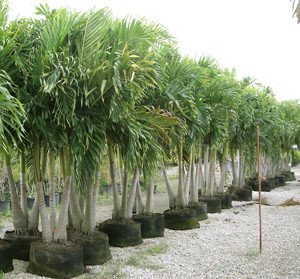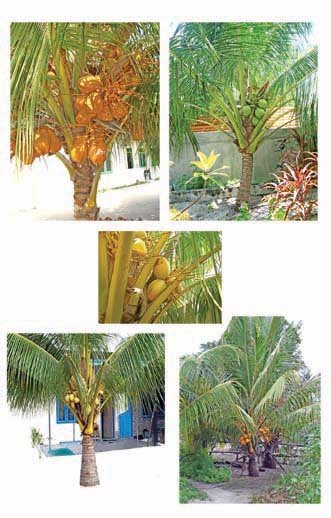Palm trees

Common names: Betel nut, areca
Dhivehi name: Fen-foah
Status: Common; grown in home gardens and cultivated in large scale.
Description: An erect, slender-stemmed, single-trunked palm that can grow up to 30 m tall but normally trees are in between 10 to 15 m in height. Trunk is green when young, grey coloured in old trees with prominent white leaf scars.
Fronds (leaves) are even-pinnately compound with a rigid but recurved rachis and 30 to 50 long lanceolate-shaped leaflets.
Frond base sheath is long, smooth and green in colour.
Flowers are yellow or creamy white in colour, fragrant and unisexual, with both male and female flowers borne on the same inflorescence. Inflorescence is commonly called as spadix (flower spike), much-branched and borne below the leaves and enclosed in a spathe.
Each terminal branch or spikelet of the inflorescence has a few female flowers at the base and numerous male flowers extending from there to the tip.
Male flowers are small in size with three petals and calyx cut into three minute lobes.
Female flowers are much larger than male flowers with three sepals and three petals.
Fruit is ovoid, hard and orange or scarlet coloured with fibrous mesocarp (middle layer) and a thin woody endocarp enclosing a seed. Seeds are ovoid or ellipsoidal and 1.5 to 1.8 cm in diameter with a flattened base.
Uses:>
Seeds of betel nut are normally cut into narrow pieces and rolled inside betel leaf, rubbed over with lime and chewed by elders and young people alike.
It is also chewed alone.
Betel nut has astringent, stimulative, digestive and cardiotonic properties exerted by tannin and alkaloid substances present in it.
It is a powerful agent to stimulate secretion of saliva.
Powered nut is effective in expelling tapeworms from human beings and also combating round worms.
Ecology, propagation and management: >
It is capable of growing in a wide variety of soil, from laterite to loamy soil, provided the soil has thorough drainage yet has capacity to retain optimum moisture.
Normally, light and sandy soils are unsuitable unless well irrigated and manured.
It has poor tolerance to drought and requires uniform moisture year-round.
Its tolerance to salt spray, salinity and wind is poor.
It is propagated only by seeds.
Fully matured, heavy fruits that float vertically in water have high germination rate and vigorous seedlings.
Fruits are planted as a whole, with husk for propagation.
Nursery-grown seedlings of one to two years old, which should bear at least five leaves, are transplanted from nursery bed to field.

Varieties of coconut: >
In the Maldives, the following varieties of coconut are commonly found:
Nulu ruh (tall variety with green-coloured fruit), Rathu ruh (tall with red-coloured fruit), Kuhi ruh (tall variety with green- and red-coloured fruit), Jafanah ruh (short variety with green-coloured fruit) and Dhanbu ruh (short variety with red-coloured fruit).
Among these, rathu ruh is more abundant and both rathu and nulu ruh are cultivated mainly for oil.
The famous kurumbapani of the Maldives is the coconut milk of dhanbu ruh.
Ecology, propagation and management:>
Coconut palm prefers a year-round warm and humid climate.
Rainfall in the range of 1500 to 2500 mm, distributed evenly throughout the year and relative humidity above 60% provide ideal climate for the vigorous growth and yield.
Presence of water table within easy reach of roots can offset inadequate rainfall.
It is well adapted to a wide variety of soils though coarse sand in the coastal areas is its natural habitat.
It grows well in deep soil and cultivated in a large scale in loamy and clayey soil that has good drainage.
It tolerates saline and infertile soils but tolerance to drought is limited.
It also tolerates wind-driven salt very well.
It has capacity to withstand cyclonic winds provided roots are well anchored.
It is propagated only by seed and does not multiply vegetatively.
Seeds can be collected from mature nuts, which are indicated by dryness of the husk and turning of outer layer from green to brown.
Seed nuts are buried two-third of their length in coarse soil to reduce the loss of nut water through evaporation.
Depending on the type, germination can occur four to six weeks after sowing and continue over an eight week period; regular watering during this period is necessary.
Germinating nuts with the first compound leaf fully developed are the best to be transferred to the nursery.
Seedlings raised in-ground should be outplanted not later than six months old whereas seedlings raised in container can be planted at about eight to ten months.
Source
Plagiarism is the copying & pasting of others work without giving credit to the original author or artist. Plagiarized posts are considered spam.
Spam is discouraged by the community, and may result in action from the cheetah bot.
More information and tips on sharing content.
If you believe this comment is in error, please contact us in #disputes on Discord
Hi! I am a robot. I just upvoted you! I found similar content that readers might be interested in:
http://www.fao.org/docrep/010/ai387e/AI387E07.htm